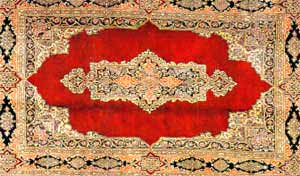Kashmiri carpets are known the world over for two things - they are handmade, never machine made, and they are always knotted, never tufted. It is extremely instructive to watch a carpet being made. A carpet may well be the most expensive purchase from your trip to Kashmir but it is a lifelong investment.
Stretched tightly on a frame is the warp of a carpet. The weft threads are passed through, the 'taleem' or design and colour specification are then worked out on this. A strand of yarn is looped through the warp and weft, knotted and then cut. The yarn used normally is silk, wool or both. Woollen carpets always have a cotton base (warp & weft), while silk usually has a cotton base. Sometimes however, the base is also of silk, in which case you will see that the fringe is silk, and the cost increases proportionately. Occasionally, carpets are made on a cotton base, mainly of woollen pile with silk yarn used as highlights on certain motifs.
When the dealer specifies the percentage of each yarn used, he is taking into account the yarn used for the base too. Therefore, a carpet with a pure silk pile may be referred to as "80 per cent silk carpet". Do not be alarmed! He is merely stating that the warp and weft are not of silk.
A third type of yarn staple, also referred to as mercerised cotton, is also mentioned here, although it is by no means traditionally Kashmiri, but a man-made fibre. Its shine is not unlike that of silk, although in price it is much lower than silk, but more expensive than wool. Staple carpets are made to fill a slot in the market – customers demand carpets, which are not unlike silk in appearance so as to blend with the decor of their houses. One important difference between silk and staple though is that pure silk is far lighter than staple per unit area.
Carpet weaving in Kashmir was not originally indigenous but is thought to have come in by way of Persia. Till today, most designs are distinctly Persian with local variations. One example, however, of a typical Kashmir carpet is the "tree of life". Persian design notwithstanding, any carpet woven in Kashmir is referred to as Kashmiri. The colour-way of a carpet and its details, differentiate it from any other carpet. It should be kept in mind that although the colours of Kashmiri carpets are more subtle and muted than elsewhere in the country, only chemical dyes are used - vegetable dyes have not been available now for a hundred years.
 |
|
The knotting of carpet is the most important aspect, determining its durability and value, in addition to its design. Basically, the more knots per square inch, the greater its value and durability. Count the number of knots on the reverse of carpet in any one square inch, and it should be roughly the same as the dealer tells you, give or take 10 knots. If you are told that a carpet contains 360 knots, and your count indicates about 10 less, it simply means that the weft has not been evenly combed down in parts -- this is not a fault, and several random checks throughout the carpet will even go above the figure of the dealer's estimate. Also, there are single and double-knotted carpets. You can quite easily identify one from the other on the reverse of the carpet. The effect that it has on the pile too is important - a double-knotted carpet has a pile that bends when you brush it one way with your hand, and stands upright when it is brushed in another direction. A single knotted carpet is fluffier and more resistant to the touch, there is no 'right' and 'wrong' side to brush it.
Points to keep in mind when choosing a carpet:
- Whether it has been made of silk pile on silk base, silk pile on cotton base, silk and wool on cotton base or wool on cotton base.
- The number of knots on the reverse of the carpet; whether one or more line in the design has been omitted completely in which case the pattern looks lopsided;
- Whether any element in the design has been wrongly woven so that one motif is larger or smaller at one end than the corresponding motif at another end, etc.
- Whether each motif or element of design has clear, crisp outlines; blurred edges indicate a fault in the weaving.
- Whether the edges of the carpet are crooked as if it had been incorrectly mounted on the frame, so that one end is broader than another.
|